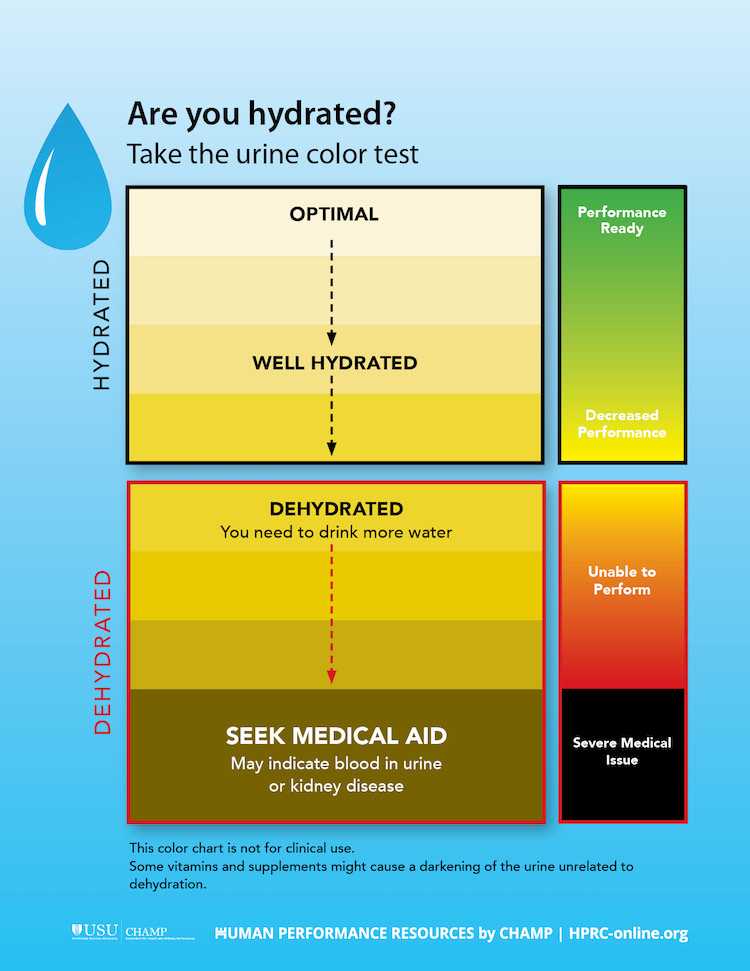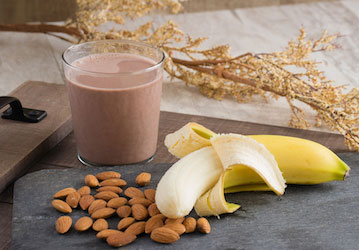When you eat is just as important as what and how much you eat for peak performance. Proper fueling helps you push through high-intensity activities, training, and extended operations.
By timing certain nutrients (carbohydrates, protein, and water) to match activity phase (before, during, and after exercise), Service Members can fuel and hydrate to perform at their best. Strategic nutrient timing also can help maintain energy, decrease injury risk, and maximize recovery.
The fluid and fuel strategies for each phase depend on the length and intensity of the Warfighter’s activity. Environmental conditions, such as heat, cold, humidity, and altitude also play a role in nutrient strategies. Everyday foods from home, dining facilities on base, grocery stores, and convenience stores can meet the nutritional needs of most Service Members. (Gels, bars, chews, and other portable “sports foods” also work well for the various phases of nutrient timing. They’re just often more expensive.)
Fueling with carbs
Carbohydrates are the best fuel for exercise—for both mind and body. Warfighters should aim to get enough carbs:
- before exercise to maximize their total supply of carbs;
- during exercise to have enough fuel to match the demands of exercise; and
- after exercise to replenish the fuel used.
The tables below show general recommendations for each phase of nutrient timing that can be customized. Warfighters should choose what to eat based on activity type, intensity, and environmental conditions, as well as their personal preference and experience.
Fluid balance
Getting enough fluids and balancing electrolytes are also essential for peak performance. Military guidelines recommend 3–4.5 quarts (96–144 fl oz) of fluid per day for men and 2–3 quarts (64–96 fl oz) for women.
Service Members need to replace fluids to cover daily water loss as well as sweat losses—especially when they’re active for a long time or at high intensity. Fluid loss of more than 2% body weight can decrease attention, mood, and athletic performance and increase risk for heat-related injuries. Drinking water with meals and snacks, and paying attention to fluid intake during and after exercise can help maintain hydration.
To monitor fluid loss, Service Members can weigh themselves before and after exercise—and rehydrate accordingly. Another way to monitor hydration is by checking urine color. (Generally, the lighter the urine color, the better.)

Service Members should aim to tailor their hydration to sweat rate, type and length of activity, environment (heat, humidity, cold, altitude), equipment and clothing, and opportunity and availability to drink. For optimal fluid balance, Warfighters likely need to increase intake with heat or humidity, heavy clothes or equipment, increased intensity, or exerising longer than an hour. By the time someone feels thirsty, they might already be dehydrated, so encourage a drinking schedule. Service Members might find that flavored and/or sweetened drinks help them drink more fluids. Rehydration is an important focus of the recovery phase, so encourage drinking immediately after a training, mission, or event.
Electrolytes
Electrolytes (nutrients such as sodium, potassium, calcium, and magnesium) are important for muscle function. Loss of electrolytes through urine and sweat can make dehydration worse than just fluid loss alone. Individual sweat rates for men and women can vary between 0.3 and 3.5 liters (about 0.3–3.7 quarts) per hour, so the amount of electrolytes lost through sweat also varies. Electrolyte loss can be significant depending on training status, sweat rate, how much you eat, genetics, and prior heat exposure.
For optimal performance and recovery, a Service Member should consume foods and fluids that contain electrolytes before, during, and after exercise. Warfighters shouldn’t restrict salt in the recovery phase; it helps retain fluids.
Service Members can get enough sodium by eating salty snacks or meals, adding salt to foods, and drinking beverages that contain sodium. Electrolytes can be found in everyday foods including bananas and oranges (high in potassium), chocolate milk (high in calcium), nuts/seeds and whole grains (high in magnesium) as well as sports drinks, sports foods, or a combination. Replenishing electrolytes is crucial for complete hydration.
Caffeine for performance
Caffeine can improve performance during an endurance event ( > 60 minutes) by reducing the perception of fatigue and allowing you to exercise longer at optimal intensity. In general, consuming up to 200 mg of caffeine (amount in 16-oz coffee) approximately 30–60 minutes before an endurance event can improve performance. When using caffeine to boost performance, use it strategically, according to individual caffeine tolerance. Caffeine content varies, and not all product labels include caffeine content.
For extended or sustained operations, re-dose every 3–4 hours as needed. Caffeine intake should not exceed 600 mg in 24 hours (or 800 mg for sustained operations). For more information, read “Caffeine and Performance” from Operation Supplement Safety (OPSS).
For more information on performance nutrition, read HPRC’s “Warfighter Nutrition Guide.”
Fueling for high-intensity activities (45–75 min)
High-intensity workouts lasting about an hour require only a small amount of additional fuel and fluid for peak performance.
|
START STRONG top off energy |
STAY STRONG maintain energy |
RECOVER STRONG refuel energy |
|
|---|---|---|---|
| WHEN |
Fluid: 2–4 hours before exercise Fuel: 30–60 minutes before exercise |
Fluid: Every 60 minutes during exercise |
Fluid: Immediately after exercise Fuel: Within 2 hours of exercise |
| WHAT |
Fluid: 14–22 fl oz water Fuel: A carb-rich meal or snack of about 200–300 calories Tip: Avoid foods high in fat (full-fat dairy) or fiber (raw veggies) to prevent stomach upset. |
Fluid: 16–32 fl oz water / hour, adjust based on environment and sweat rate; no more than 48 fl oz per hour Consider a sports drink when conditions are hot or humid |
Fluid: Water with meals and snacks Fuel: Your next planned “balanced” meal, but eat a snack if your meal is more than 2 hours away |
| WHY |
To start hydrated and provide enough energy for working muscles |
To prevent dehydration by replacing fluids lost through sweat |
To replenish fuel stores (glycogen), replace fluids and electrolytes, and repair damaged tissue |
Fueling for longer endurance activities (> 60 minutes)
Extended endurance activities—such as a Ruckmarch, extended field operations, a marathon, and playing soccer or other “stop and start” sports—require more fuel and hydration to sustain performance before, during, and after each event.
|
START STRONG top off energy |
STAY STRONG maintain energy |
RECOVER STRONG refuel energy |
|
|---|---|---|---|
| WHEN |
Fluid: 2–4 hours before and up to start of exercise Fuel: 1–4 hours before exercise Tip: Measure your starting weight before you eat, dress, or exercise. |
Fluid: Every 60 minutes during exercise Fuel: Every 45–60 minutes during exercise |
Fluid: Immediately after exercise Fuel: Within 2 hours after exercise Tip: Check your post-exercise weight and calculate change in weight. Ex: 185-183 = 2 lb lost in sweat. |
| WHAT |
Fluid: 14–22 fl oz water Fuel: 1–4 g carb/kg (0.5–1.8 g carb/lb) Adjust timing and amount of carbs to match schedule, activity, and preference Tip: Choose foods low in fat and fiber to prevent stomach upset. Avoid new or unfamiliar foods the day of an event, race, or mission. Experiment during training instead. Optional: Caffeine (200 mg) |
Fluid: 16–32 fl oz per hour water, sports drink, or a mixture of both; do not exceed 48 fl oz / hour Fuel: For exercise up to 2.5 hours, consume 30–60 g carb/hour from food and fluids. For ultra-endurance events (longer than 3 hours), consume up to 90 g carb/hour from food and fluids. Choose from easily digestible carbs, such as fruit, grains, and sports drinks. Tip: Try different types or brands of sports drinks to find what works best for you. Or make your own. Optional: Caffeine (200 mg) |
Fluid: 20–24 fl oz sports drink or water per pound lost during exercise; or drink until urine is pale yellow Fuel: Choose a meal containing carb-rich foods and 15–30 grams protein. Or eat a snack if the next meal is more than 2 hours away. Tip: Replace more water and sodium than was lost. It’s important to choose foods (such as pretzels, peanut butter crackers, or salted nuts) and beverages (such as sports drinks) that contain sodium. Look for moderate or high sodium options at your dining facility. |
| WHY |
To start hydrated and provide adequate fuel for working muscles |
To prevent dehydration by replacing fluids and electrolytes lost through sweat, and to provide carbs to refuel muscles and maintain blood sugar levels |
To restore fuel (glycogen), replace fluids and electrolytes, and repair damaged tissues |
| FLUID & FUEL IDEAS |
Fluid: 14–22 fl oz water Fuel example: For a 185 lb (84 kg) Service Member fueling with 1g carb/kg, choose one of the following:
|
Fluid: 16–32 fl oz per hour water, sports drink, or a mixture of both Fuel examples (at least 1–2 per hour):
|
Fluid: 20–24 fl oz per hour water, sports drink, or a mixture of both Fuel example: Choose one of the following: Meals:
Snack:
|
